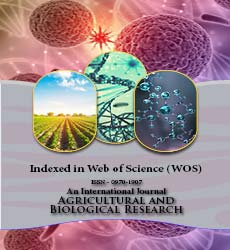Agricultural and Biological Research
RNI # 24/103/2012-R1
Belay Beyene Mekonnen*, Ousman Ahimmed Mohammed, Hayillu Gebrekirstos Hagos
Maize, a vital staple in Ethiopia, confronts a significant threat from Fall Armyworm (FAW), (Spodoptera frugiperda J.E. Smith), a pervasive agricultural pest. To tackle this challenge, field experiments were conducted in collaboration with agro-pastoralist farmers to assess the effectiveness of neem aqueous leaf and seed extracts as botanical insecticides against FAW infestation and damage on irrigated maize fields situated in the lowland tropical agro-pastoral ecological zone of Ethiopia, particularly at Berga agropastoral Keble, Aysayita Woredas, Afar. The objective was to determine the optimal dosage of neem insecticide for controlling FAW infestation and reducing damage to maize crops. This approach ensures the ease of disseminating and implementing the study's results at the local level, simplifying the preparation process for farmers. Data analysis utilized SPSS Version 25, employing the Least Significant Difference (LSD) method at a significance level of p ≤ 0.05. Results indicated that the control group exhibited the highest count of fall armyworm larvae (2.9298 ± 0.23329) and associated damage (1.2982 ± 0.11731), whereas neem seed oil at a concentration of 0.3984% demonstrated the lowest larval count (1.2632 ± 0.12141) and damage (0.3860 ± 0.06505). All neem extract treatments were exhibited the significant variations in larval numbers and incidence per plant (p ≤ 0.05). However, no significant differences LSD tests (p ≥ 0.05) were observed in the mean number of larvae per plant among neem seed oil treatments. Furthermore, there were no significant variances LSD tests (p ≥ 0.05) in mean larval damage per plant among neem seed oil treatments and neem leaf extracts at a concentration of 4.76%. Notably, neem leaf extracts at a concentration of 4.76% displayed a larval infestation rate of (1.7719 ± 0.17703) and damage level of (0.5965 ± 0.07018), highlighting its cost-effectiveness due to the scarcity of neem seeds and seasonal agricultural constraints in the study area. Overall, neem extract emerges as a promising control agent, offering minimal impact on non-target organisms, environmental friendliness and low human health risks. Additionally, its accessibility, affordability and locallevel preparatory ease enhance its suitability for adoption in agricultural practices.
